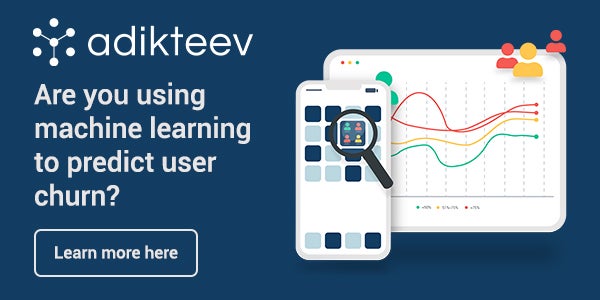For app marketers, success comes down to answering one question: Which users are most likely to churn?
Just as it has democratized more data-driven approaches to so much other business decision-making, machine learning is fundamentally changing churn prediction from an inexact art into a precise science.
Remarketing and the all-or-nothing conundrum
Today, most marketers are reluctant to admit that their strategies for remarketing fall on one side of the all-or-nothing spectrum. Many aren’t targeting active users at all. When they put all their eggs in the user acquisition (UA) basket, they often overpay for new users who are likely to churn after seven days.
Even the savviest app marketers’ strategies often involve a lot more guesswork than they’d like. There’s simply too much data, and choosing a single source of truth (SSOT) can be difficult without the right resources or time to dedicate to finding it.
The secret sauce of ML-driven churn prediction
Machine learning (ML) takes all that granular, raw data on users’ app activity and combines it with monetary signals around users’ in-app spending. After looking at data, such as how frequently they’re engaging, how long their sessions last, the last time they engaged, etc., the ML framework packages all those signals and compares them against historical user data where the outcomes are known (e.g., who churned, who stayed and for how long, how much incremental revenue they generated, etc.).
The primary output is a definitive churn prediction score that rates the probability that a user will not come back to the app (at some point).
Another set of useful outputs estimate the expected frequency of a user’s app engagements over a given future time period: How often will this user come back to the app over the next one, seven, 14 or 30 days, for example?
Using churn prediction to fuel retargeting and beyond
Churn prediction scoring lets you drive a real-time approach to retargeting, focusing on those users that are most likely to churn – but aren’t lost yet – to drive return on marketing spend while ensuring strong incrementality. By using these ML models to predict which users are likely to leave the app, app marketers can more accurately target lapsed payers and any other high-value users who drive in-app revenue. In this way, they can focus on retention over reacquisition.
User churn prediction models can actually have an impact on all aspects of user retention, from in-app messaging strategies to product development. Models can be integrated in a CRM to serve in-app messaging to users with a low retention score. If the product team finds that users are getting a low retention score after a certain point in the user journey, they can analyze why this might be happening and make appropriate updates to the app. Even the timing of push and email notification strategies can be adjusted depending on churn prediction model scoring.
Marketers still need to test and learn to find the incrementality sweet spot
For most companies, moving to this machine learning approach will drive immediate gains in key revenue metrics across retargeting and cross-promo efforts. But one of the biggest pitfalls is assuming these initial improvements are as good as it gets.
Moreover, as practical and accessible as these ML tools are, the technology is still far from one-size-fits-all. Those churn prediction scores don’t tell a marketer exactly where to draw the line – what churn probability equates to incrementality. Defining that threshold remains challenging because there is no magic number or industry benchmark.
The distribution of scores and the correlation between probability and incrementality can vary widely between apps – even within the same app ecosystem. Apps with strong retention will likely have extremely cautious churn score thresholds – perhaps only the top 3% to 5%. If retention dynamics are short and less stable, such as with more casual apps, it makes sense to get more aggressive with remarketing. That might mean that you could see incremental uplift on as much as the top 80% of churn prediction scores.
But just like gauging churn likelihood, determining optimal thresholds should be a science, not an art. Apps using churn prediction modeling should make it easy to test and learn through incrementality measurement and back-testing on past data.
Adikteev ML-driven churn prediction scoring is already proving a powerfully practical way for app marketers to rapidly increase their level of maturity, sophistication and success when it comes to retargeting and remarketing as a whole. And those willing to put in the extra work can finally hit the sweet spot of reengagement: connecting with users before they churn, while having confidence that their likelihood to churn means the spend is driving incremental revenue.















